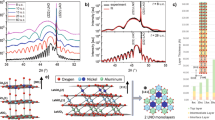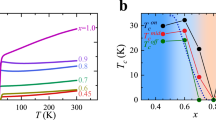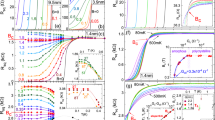Abstract
Superconductors show zero resistance to electric current, and expel magnetic flux (the Meissner effect) below the transition temperature (Tc). In conventional superconductors, the ‘Cooper pairs’ of electrons that are responsible for superconductivity form only below Tc. In the unconventional high-Tc superconductors, however, a strong electron correlation is essential for pair formation: there is evidence1,2,3,4,5 that some pairs are formed above Tc in samples that have less than the optimal density of charge carriers (underdoped) and an energy gap—the ‘pseudogap’—appears to be present. Moreover, excitations that look like the vortices that carry magnetic flux inside the superconducting state have been reported above Tc (refs 6, 7). Although the origin of the pseudogap remains controversial8,9,10,11, phase fluctuations above Tc, leading to some form of local superconductivity or local pairing, seem essential9,12,13,14,15,16. Here we report magnetic imaging (scanning SQUID microscopy) of La2-xSrxCuO4 thin films. Clear quantized vortex patterns are visible below Tc (18–19 K), and we observe inhomogeneous magnetic domains that persist up to 80 K. We interpret the data as suggesting the existence of diamagnetic regions that are precursors to the Meissner state.
This is a preview of subscription content, access via your institution
Access options
Subscribe to this journal
Receive 51 print issues and online access
$199.00 per year
only $3.90 per issue
Buy this article
- Purchase on Springer Link
- Instant access to full article PDF
Prices may be subject to local taxes which are calculated during checkout




Similar content being viewed by others
References
Timusk, T. & Statt, B. The pseudogap in high-temperature superconductors: an experimental survey. Rep. Prog. Phys. 62, 61–122 (1999).
Loeser, A. G. et al. Excitation gap in the normal state of Bi2Sr2CaCu2O8+δ. Science 273, 325–329 (1996).
Ding, H. et al. Spectroscopic evidence for a pseudogap in the normal state of underdoped high-Tc superconductors. Nature 382, 51–54 (1996).
Imai, T. et al. Cu spin dynamics in high Tc and related oxides investigated by nuclear spin-lattice relaxation. Physica C 162–164, 169–170 (1989).
Corson, J., Mallozzi, R., Orenstein, J., Eckstein, J. N. & Bozovic, I. Vanishing of phase coherence in underdoped Bi2Sr2CaCu2O8+δ. Nature 398, 221–223 (1999).
Xu, Z. A., Ong, N. P., Wang, Y., Kakeshita, T. & Uchida, S. Vortex-like excitations and the onset of superconducting phase fluctuation in underdoped La2-xSrxCuO4. Nature 406, 486–488 (2000).
Lee, P. A. Some vortices like it hot. Nature 406, 467–468 (2000).
Orenstein, J. & Millis, A. J. Advances in the physics of high-temperature superconductivity. Science 288, 468–474 (2000).
Emery, V. J. & Kivelson, S. A. Importance of phase fluctuations in superconductors with small superfluid density. Nature 374, 434–437 (1995).
Moriya, T., Takahashi, Y. & Ueda, K. Antiferromagnetic spin fluctuations and superconductivity in two-dimensional metals—a possible model for high Tc oxides. J. Phys. Soc. Jpn 59, 2905–2915 (1990).
Monthoux, P., Balatsky, A. V. & Pines, D. Toward a theory of high-temperature superconductivity in the antiferromagnetically correlated cuprate oxides. Phys. Rev. Lett. 67, 3448–3451 (1991).
Doniach, S. & Inui, M. Long-range Coulomb interactions and the onset of superconductivity in the high-Tc materials. Phys. Rev. B 41, 6668–6678 (1990).
Roddick, E. & Stroud, D. Effect of phase fluctuations on the low-temperature penetration depth of high-Tc superconductors. Phys. Rev. Lett. 74, 1430–1433 (1995).
Roshsar, D. & Kivelson, S. A. Superconductivity and the quantum hard-core dimer gas. Phys. Rev. Lett. 61, 2376–2379 (1988).
Sá de Melo, C. A. R., Randeria, M. & Engelbrecht, J. R. Crossover from BCS to Bose superconductivity: transition temperature and time-dependent Ginzburg-Landau theory. Phys. Rev. Lett. 71, 3202–3205 (1993).
Carlson, E. W., Kivelson, S. A., Emery, V. J. & Manousakis, E. Classical phase fluctuations in high temperature superconductors. Phys. Rev. Lett. 83, 612–615 (1999).
Tsuei, C. C. et al. Pairing symmetry and flux quantization in tricrystal superconducting ring of YBa2Cu3O7-δ. Phys. Rev. Lett. 73, 592–596 (1994).
Tsuei, C. C. & Kirtley, J. R. Pairing symmetry in cuprate superconductors. Rev. Mod. Phys. 72, 969–1016 (2000).
Sugimoto, A., Yamaguchi, T. & Iguchi, I. Supercurrent distribution in high-Tc superconducting YBa2Cu2O7-y thin films by scanning superconducting quantum interference device microscopy. Appl. Phys. Lett. 77, 3069–3071 (2000).
Morooka, T., Nakayam, S., Odawara, A. & Chinone, K. Observation of superconducting device using magnetic imaging system with a micro-DC superconducting quantum interference device magnetometer. Jpn J. Appl. Phys. 38, L119–L122 (1999).
Emery, V. J., Kivelson, S. A. & Tranquada, J. M. Stripe phases in high-temperature superconductors. Proc. Natl Acad. Sci. USA 96, 8814–8817 (1999).
Zaanen, J. Self-organized one dimensionality. Science 286, 251–252 (1999).
Kiryukhin, V. et al. Multiphase segregation and metal-insulator transition in single crystal La5/8-yPryCa3/8MnO3. Phys. Rev. B 63, 24420-1–24420-7 (2000).
Emery, V. J. & Kivelson, S. A. Frustrated electronic phase separation and high-temperature superconductors. Physica C 209, 597–621 (1993).
Acknowledgements
We thank M. Ueda and M. Koyanagi for discussions, and I. Tanaka for providing LSCO single crystals. This work was supported by the CREST program (Core Research for Evolutional Science and Technology) of the Japan Science and Technology Corporation (JST).
Author information
Authors and Affiliations
Corresponding author
Rights and permissions
About this article
Cite this article
Iguchi, I., Yamaguchi, T. & Sugimoto, A. Diamagnetic activity above Tc as a precursor to superconductivity in La2-xSrxCuO4 thin films. Nature 412, 420–423 (2001). https://doi.org/10.1038/35086540
Received:
Accepted:
Issue Date:
DOI: https://doi.org/10.1038/35086540
This article is cited by
-
Microscopic theory of novel pseudogap phenomena and Bose-liquid superconductivity and superfluidity in high-\(T_c\) cuprates and other systems
Pramana (2023)
-
EPR Study of the Local Magnetic Field Distribution over the Bi2Sr2Ca1−x Y x Cu2O8+y Crystal Surface above the Superconducting Transition Temperature
Applied Magnetic Resonance (2015)
-
Ordering of Dopants and Potential Increase in T c to Near-room Temperature
Journal of Superconductivity and Novel Magnetism (2012)
-
Inhomogeneous Superconducting State and Intrinsic T c : Near Room Temperature Superconductivity in the Cuprates
Journal of Superconductivity and Novel Magnetism (2012)
-
The Meissner effect in a strongly underdoped cuprate above its critical temperature
Nature Communications (2011)
Comments
By submitting a comment you agree to abide by our Terms and Community Guidelines. If you find something abusive or that does not comply with our terms or guidelines please flag it as inappropriate.



